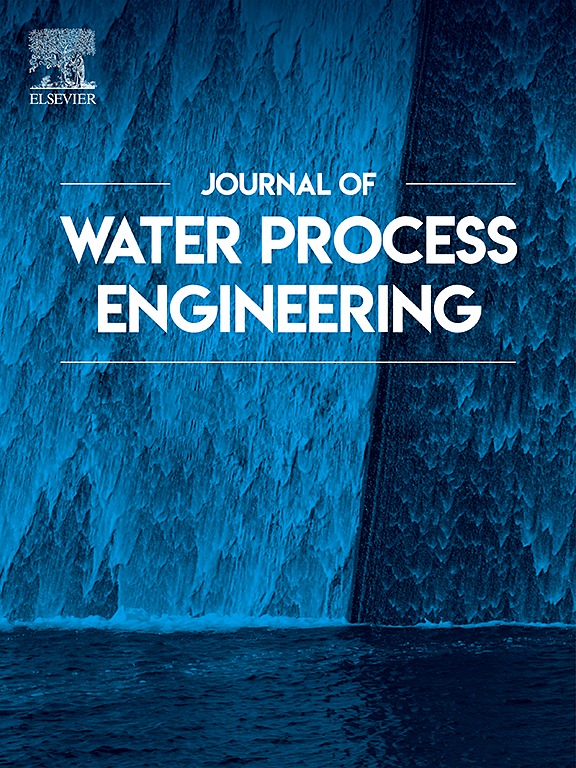微波辅助H2O2/驱动降解对乙酰氨基酚和萘普生的黄铜矿/MWCNT有序催化剂的电子活化调控及其机理
IF 6.3
2区 工程技术
Q1 ENGINEERING, CHEMICAL
引用次数: 0
摘要
微波辅助催化的一个关键挑战是催化剂寿命短和电子活性控制差。在这项工作中,我们证明了多壁碳纳米管(MWCNTs)作为有序的碳质载体用于黄铜矿(CuFeS₂)纳米颗粒,可以精确控制辐射诱导的效应。在较温和的条件下(500w, 0.5 g L−1催化剂,H2O2用量为1.28 mM L−1),对乙酰氨基酚(ACT)和萘普生(NPX)分别在12和16 min内完全矿化。动力学分析表明分子降解速度更快(kACT = 0.4592±0.021 min−1;kNPX = 0.4439±0.019 min−1)大于矿化(kACT = 0.2257±0.009 min−1;kNPX = 0.2163±0.007 min−1),表明中间有机化合物的形成。该系统在20个循环中保持了80%以上的全球效率,尽管降解率降低了50%。这种高性能归因于CuFeS2/MWCNT异质结构的电子迁移率增强的协同效应。实验和理论分析揭示了两种主要的降解途径:(i)羟基自由基(•OH)控制初始分解,(ii)电荷转移机制驱动矿化。基于质谱裂解模式的量子化学计算澄清了关键中间体的反应性及其与每个途径的对齐。最后,生态毒理学分析证实,降解副产物对模式生物的危害明显小于母体化合物。该研究促进了对微波反应催化剂机理的理解,为去除药物污染物提供了一种可回收、高效、环保的方法。本文章由计算机程序翻译,如有差异,请以英文原文为准。
Tuning of electronic activation and mechanisms in chalcopyrite/MWCNT ordered catalyst for microwave-assisted H2O2/driven degradation of paracetamol and naproxen
A key challenge in microwave-assisted catalysis lies in the short catalyst lifespan and poor control of electronic activity. In this work, we demonstrate that multi-walled carbon nanotubes (MWCNTs), used as ordered carbonaceous supports for chalcopyrite (CuFeS₂) nanoparticles, enable precise control over irradiation-induced effects. Under mild conditions (500 W, 0.5 g L−1 catalyst, H2O2 dosage of 1.28 mM L−1), complete mineralization of acetaminophen (ACT) and naproxen (NPX) was achieved within 12 and 16 mins, respectively. Kinetic analysis revealed faster molecular degradation ( = 0.4592±0.021 min−1; = 0.4439±0.019 min−1) than mineralization ( = 0.2257±0.009 min−1; = 0.2163±0.007 min−1), indicating the formation of intermediate organic compounds. The system maintained over 80% global efficiency across 20 cycles, despite a 50% reduction in degradation rate. This high performance is attributed to synergistic effects from the enhanced electronic mobility of the CuFeS2/MWCNT heterostructure. Experimental and theoretical analyses revealed two main degradation pathways: (i) hydroxyl radicals (•OH) governing the initial breakdown, and (ii) charge-transfer mechanisms driving mineralization. Quantum chemical calculations based on fragmentation patterns from mass spectrometry clarified the reactivity of key intermediates and their alignment with each pathway. Finally, ecotoxicological assays confirmed that the degradation byproducts were significantly less harmful to model organisms than the parent compounds. This study advances the mechanistic understanding of microwave-responsive catalysts and offers a recyclable, efficient, and environmentally benign approach for pharmaceutical pollutant removal.
求助全文
通过发布文献求助,成功后即可免费获取论文全文。
去求助
来源期刊

Journal of water process engineering
Biochemistry, Genetics and Molecular Biology-Biotechnology
CiteScore
10.70
自引率
8.60%
发文量
846
审稿时长
24 days
期刊介绍:
The Journal of Water Process Engineering aims to publish refereed, high-quality research papers with significant novelty and impact in all areas of the engineering of water and wastewater processing . Papers on advanced and novel treatment processes and technologies are particularly welcome. The Journal considers papers in areas such as nanotechnology and biotechnology applications in water, novel oxidation and separation processes, membrane processes (except those for desalination) , catalytic processes for the removal of water contaminants, sustainable processes, water reuse and recycling, water use and wastewater minimization, integrated/hybrid technology, process modeling of water treatment and novel treatment processes. Submissions on the subject of adsorbents, including standard measurements of adsorption kinetics and equilibrium will only be considered if there is a genuine case for novelty and contribution, for example highly novel, sustainable adsorbents and their use: papers on activated carbon-type materials derived from natural matter, or surfactant-modified clays and related minerals, would not fulfil this criterion. The Journal particularly welcomes contributions involving environmentally, economically and socially sustainable technology for water treatment, including those which are energy-efficient, with minimal or no chemical consumption, and capable of water recycling and reuse that minimizes the direct disposal of wastewater to the aquatic environment. Papers that describe novel ideas for solving issues related to water quality and availability are also welcome, as are those that show the transfer of techniques from other disciplines. The Journal will consider papers dealing with processes for various water matrices including drinking water (except desalination), domestic, urban and industrial wastewaters, in addition to their residues. It is expected that the journal will be of particular relevance to chemical and process engineers working in the field. The Journal welcomes Full Text papers, Short Communications, State-of-the-Art Reviews and Letters to Editors and Case Studies
 求助内容:
求助内容: 应助结果提醒方式:
应助结果提醒方式:


